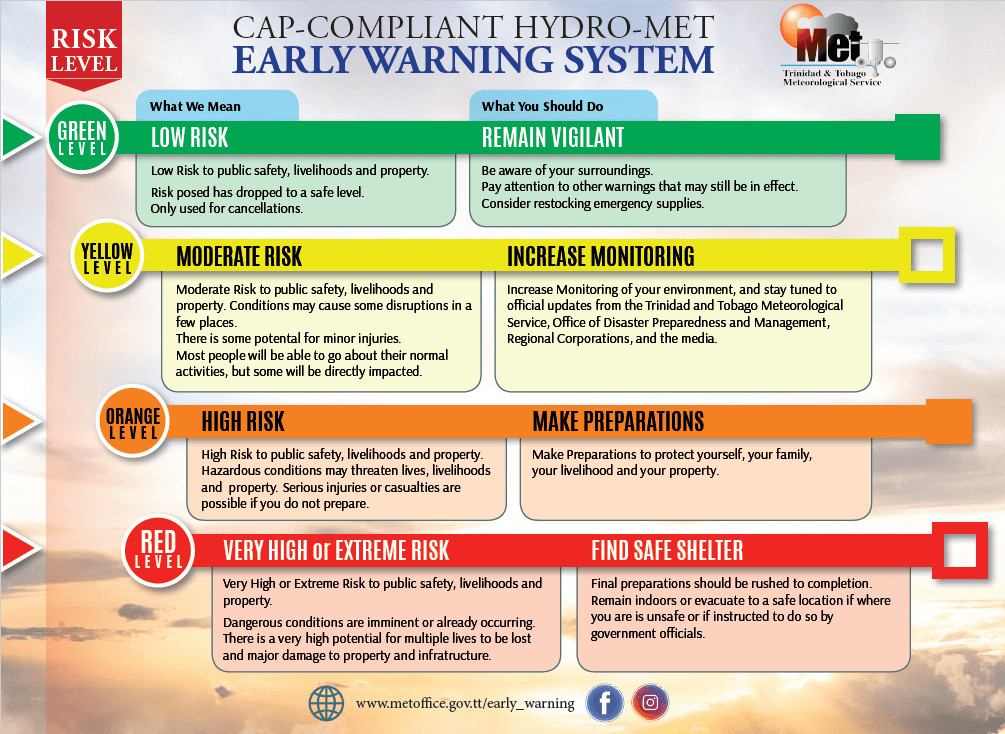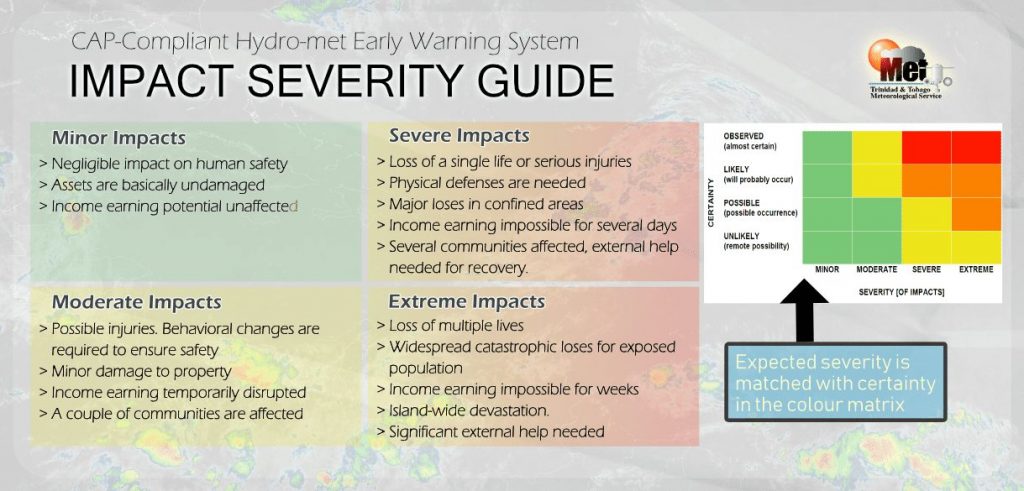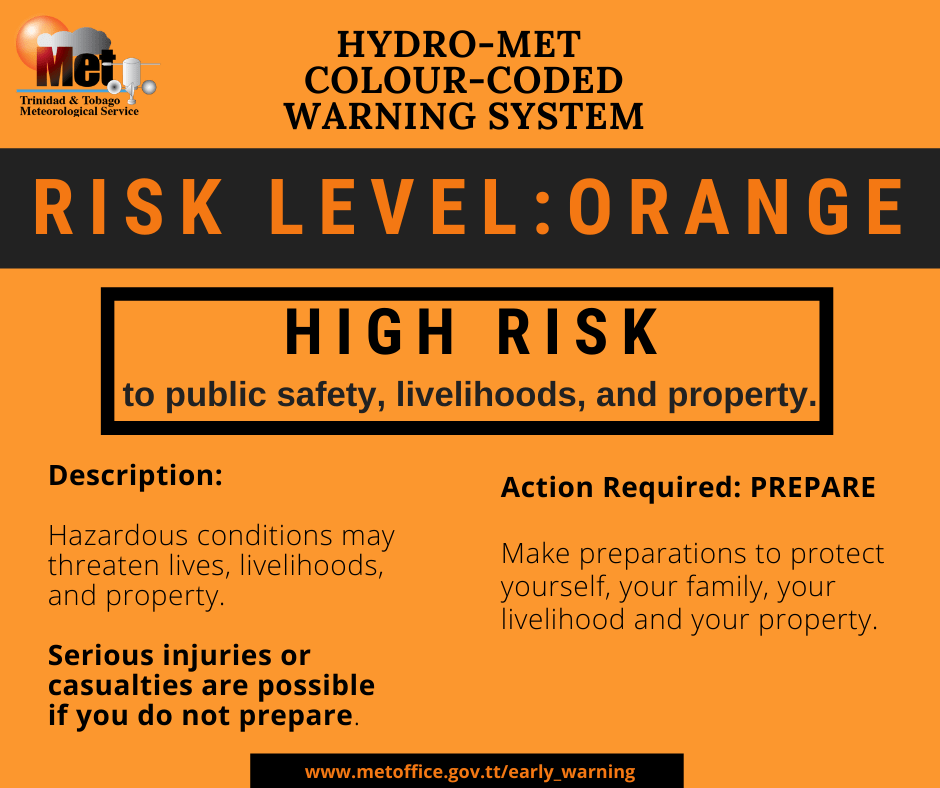Long-period swells originating from powerful low-pressure systems in the North Atlantic are now moving across the Lesser Antilles, forecast to begin affecting Trinidad and Tobago from Friday afternoon. These high-energy waves have been affecting the country since December 9th, 2022.
However, with longer period swells, larger and more impactful waves are now forecast to affect the country, with severe impacts likely. This is the first-ever Orange-Level Hazardous Seas Alert issued by the Trinidad and Tobago Meteorological Service since the start of the color-coded Multi-Hazard Early Warning System’s debut in 2018.
What you need to know
— What is happening: Beginning Friday afternoon, swells with periods of up to 19 seconds are forecast to affect Trinidad and Tobago’s northern coastlines. Over the next seven days, swells are forecast to continue, eventually affecting sheltered, north-facing coastlines of Trinidad in the Gulf of Paria.
— What can we expect: Large, battering waves along T&T’s northern coastlines with wave heights up to 3.5 meters (11.5 feet), with choppy conditions in sheltered areas. Moderate to significant coastal erosion is likely. There is a very high risk of dangerous rip currents along the country’s northern coastlines. Spring Tides end on Monday, December 26th, 2022, with the overall sea state in open waters rough through the alert period.
— Alerts/Watches/Warnings: A Hazardous Seas Alert (Orange Level) remains in effect for northern Trinidad and Tobago from 2:00 PM Friday, December 23rd, 2022, and remains in effect through 12:00 PM Wednesday, December 28th, 2022, from the Trinidad and Tobago Meteorological Service. There are no tropical storm or hurricane watches or warnings in effect for T&T at this time.
The Hazardous Seas Alert
The Trinidad and Tobago Meteorological Service issued a Hazardous Seas Alert (Orange Level) on Thursday at 2:20 PM. The alert goes into effect for northern Trinidad and Tobago from 2:00 PM Friday, December 23rd, 2022, and remains in effect through 12:00 PM Wednesday, December 28th, 2022. Swells are forecast to propagate into the Gulf of Paria over the weekend, affecting the north-facing coastlines of southwestern Trinidad.
Trinidad and Tobago is not under any tropical storm watch or warning at this time.


“Large breaking waves near 3.5 meters, due to long period swells, are likely along nearshore, north-exposed coastlines of Trinidad and Tobago. Choppy conditions are also likely, especially along northern-facing coastlines in the Gulf of Paria. Conditions will be amplified during high tides and exacerbated at spring tides. Effects will first be experienced on the northern shorelines of Tobago and then Trinidad within a couple of hours afterward. Impacts include dangerous conditions for swimming and small craft operations, very high surf, and dangerous rip currents near affected coastlines. Waves are currently 2.0-2.5 meters in open waters and near 0.5 meters in sheltered areas. More information: www.metoffice.gov.tt/ Update: 2022/12/23 at 6:00 PM or sooner if warranted,” according to the Trinidad and Tobago Meteorological Service. This “alert” status takes into account the possibility of the event occurring. This hazardous sea event is likely.

The color of the alert indicates the severity of the event and the probability of the event occurring. Currently, the alert level is Orange. This means that the hazards are likely, but the severity of impacts is severe for this particular alert. Large, battering waves in nearshore areas are forecast, producing dangerous conditions for all nearshore marine interests with a high risk of rip currents and beach erosion.
For a severe Hazardous Seas Alert, there is the potential for a loss of a single life or serious injuries; physical defenses are needed, major losses are possible in confined areas, income earning is impossible for several days, and several communities are affected where external help is needed for recovery.
Coastal communities, sea bathers, fishermen, and small craft operators should finalize preparations to protect lives, livelihoods, and property, activate their safety plan, secure food, water, and medicine for at least seven days, and protect important assets and documents. The Met Office is advising the public to exercise extreme caution along the coast and prepare for dangerous breaking waves and currents. Follow all instructions of lifeguards and monitor official news sources.


Forecast and Impacts

Over the next seven days, seas are forecast to be moderate to rough into next week. Waves in open waters, and nearshore areas of northern Trinidad and Tobago, are forecast to be generally between 2.5 to 3.5 meters through the forecast period. In sheltered areas, waves are forecast to be less than 1.0 meters, choppy, and occasionally higher.
Prior to Friday afternoon, swell periods are forecast to remain below 15 seconds. From Friday afternoon to Tuesday afternoon, swell periods between 14 and 19 seconds are forecast, peaking Friday night through Saturday afternoon. Swells are forecast to subside by Wednesday through next week gradually.
Winds are forecast to be fresh to strong through next week, with sustained winds between 15 and 20 knots from the east to northeast. Gusts during this period are forecast to reach 30 knots, especially in the vicinity of brief showers.
Spring tides are forecast to end on December 26th, 2022. Dangerous, breaking waves, beach erosion, and rip tides are all forecast to be amplified by these higher-than-usual high tides and lower-than-usual low tides.


Saharan Dust is also forecast to remain at mild levels through the forecast period, marginally reducing visibility and air quality across Trinidad and Tobago.
Impacts from long-period swells and battering waves include the following:
- Coastal erosion;
- Coastal flooding;
- Localized disruptions of businesses;
- Sea search and rescue disruptions;
- Damage or loss of boats and fishing equipment;
- Disruptions to marine recreation and businesses
- Economic losses.
There is also the potential for loss of life and injuries. There is a very high risk of rip currents, strong currents that can carry even the strongest swimmers out to sea.
How to spot a rip current
Rip Currents
High surfs can knock spectators off exposed rocks and jetties. Breaking waves may occasionally impact harbors making navigating the harbor channel dangerous.
Saltwater will likely splash onto low-lying coastal roads such as Pigeon Point Road, the Guayaguayare Mayaro Road at the Guayaguayare Sea Wall, and the Manzanilla-Mayaro Road. Bays and beaches may become inundated, particularly along the northern coastlines of the country.
Coral reefs may experience increased stress and damage, in addition to localized beach erosion, particularly in areas where battering waves focus.










